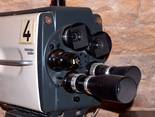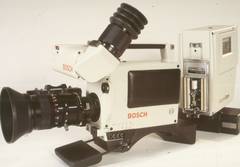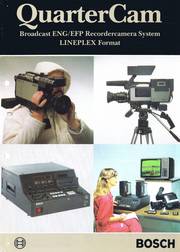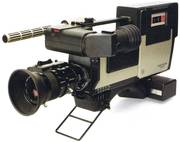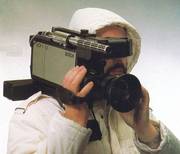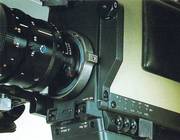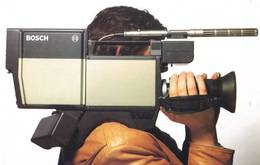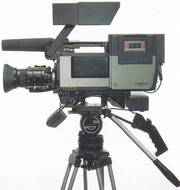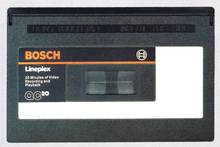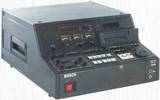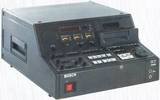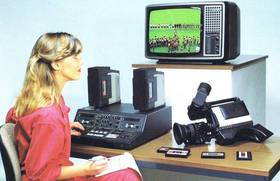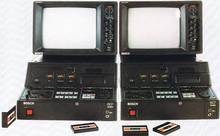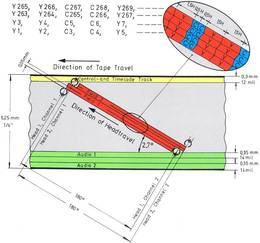- eine Seite zurück
- zur nächsten Seite
Zum Auffrischen und Erinnern . . . .
. . . sind diese Seiten hier gedacht, denn viele wissen nicht mehr oder noch nicht, wie es damals angefangen hat und wie das wirklich funktioniert mit dem Fernsehen, den Kameras, den Videorecordern, den Tonband- und den Magnetband- geräten aus alter Zeit. Viele Bilder können Sie durch Anklicken vergrößern.
Das Quartercam Projekt der Fese "KBF 1" (1984)
Ziel war eine transportable Kamera mit angedocktem Lineplex Recorder auf der Basis der kleinen 1/4" CVC Kassette.
Das Projekt ging (im Nachhinein gesehen) voll in die Hose. Kurz gefaßt wollte man eine kleine handliche EB Kamera mit angedocktem 1/4" Recorder auf analoger Basis mit analoger Video-Kompression mit allen nur möglichen Tricks auf die Beine stellen. Die Theorie war zu der Zeit natürlich schlagkräftig, doch in der Praxis gab es Hürden ohne Ende.
Das erste waren die Aufnahme-Röhren in der Kamera. Egal, wie effizient man die Elektronik zusammen-quetschte, der Stromverbrauch der 3 Plumbicon Röhren fraß alle Einsparungen wieder auf. Und Philips rückte nicht mit den bereits entwickelten CCD Chips raus. Auch RCA und Kodak waren da am Entwickeln, aber es war alles noch nicht reif. Die Japaner waren natürlich auch an dieser neuen Technologie dran, nur wußten die zu gut, daß sie das alles erst mal geheim halten mußten.
Und dann auch noch das Recorder-Problem.
Auch der Recorder mußte klein sein und die Fese sah sich finanziell und personalmäßig nicht mehr imstande, auch noch den Recorder neu zu entwickeln. Also ging "man" auf die Suche, wo in Japan oder Taiwan (oder auch im Rest der Welt) ein Band-Laufwerk mit den benötigten Spezifikationen erhältlich sei.
Das war zu dieser Zeit schwer, denn VHS schied aus, BetaMax schied aus, Umatic sowieso und das Akai Linearverfahren war bereits tot. Der AKAI 1/4" Recorder war viel zu groß und qualittativ zu schlecht. Fündig wurde man bei FUNAI in Taiwan, (die bereits Grundig und Siemens mit einem besonders billigen und elend schlechten Schrägspur-Laufwerk in die Pfanne geklopft hatten).
Doch dieses FUNAI Mehrmotoren-Laufwerk machte (vordergründig) einen besseren Eindruck. Den genauen Hergang der Evaluierung (des Prototyps) konnte mir niemand mehr erzählen, doch es wurden etwas über 40 oder sogar 50 dieser Laufwerke eingekauft.
Doch das steht alles im Magnetbandmuseum auf der Lineplex Seite.
.
Hier der Quartercam Prospekt vom Nov. 1984
Verwirrung mit den Bezeichnungen KBF1, KCF1 und BCF1
Man muß es mühsam herauskramen, was was bedeutet. Also das gesamte System wird KBF benannt, die Kamera KCF und der Recorder BCF. In fast alle Publikationen kommt das nicht beim Kunden an. Und wenn etwas beim Kunden nicht oder ausgesprochen negativ ankommt, ist der Flop vorprogrammiert.
Ein weiteres Beispiel von BTS/Philips Broadcast war 1999 der technisch einmalige Digital-Recorder, der "Voodoo" Recorder. Er war wirklich herausragend, einmalig auf der Welt und dennoch ein totaler Flop - eben ein Voodoo. Von den 500 projektierten Exemplaren wurden nur etwa mehr als 60 Stück verkauft.
.
KCF Color Camera - The Camera of the QuarterCam System
The KCF 1 is a very light and compact camera. It weighs only 6.2 kg, including the battery, small viewfinder and lens, and is therefore very suitable for ENG applications.
The KCF 1 is an integral part of the QuarterCam system. For ENG or EFP operation a large viewfinder can be attached, which can even be used when the camera is carried on the shoulder. The extra grip to operate the lens and start the VTR is a valuable aid to the cameraman during lengthy productions.
Portable cameras are very often used as an extra camera in the studio or in an OB van. The KCF 1 can be used up to 50 m away, using the remote control.
The KCF 1 is light and the camera body has a small volume. This makes it possible for the cameraman to see the surrounding area on the right of the camera when it is shoulder-mounted. The exchangeable shoulder pad allows the position of the camera to be changed and thus adapted to the requirements of the cameraman.
The KCF 1 is easy to operate. The aim is for the cameraman to be able to concentrate completely on the subject in question. For example, three different automatic iris settings provide trouble-free "exposure":
- 1) Peak level.
- 2) Mean value measurement, whereby the upper part of the picture (sky) is given a lesser priority.
- 3) Spot measurement.
With the aid of a window in the middle of the viewfinder picture, this allows the iris to correctly evaluate important parts of the scene (operates on the same basis as a film camera).
If the automatic iris is switched off, 2 zebra patterns* (which can be switched off) enable a quick assessment of whether the iris setting is correct.
A narrow zebra pattern appears only in those parts of the picture which show a 70% level, i.e. not in the lighter or darker parts of the picture. At 70 % level a face, for example, is at the correct picture level. A wider zebra pattern appears in any part of the picture which exceeds 100 %. The cameraman can therefore always see whether important parts of the nicture are too bright.
The color balance is particularly easy to operate. The black level does not need to be adjusted as the KCF 1 shows a very stable, uniform black level. If the switch is set to pre-set, a pre-set white balance is carried out automatically for that filter, i.e. if the filter wheel is set to 3200 K the color balance is correct for artificial lighting and at 5600 K it is right for normal daylight.
Of course, automatic white balance can be carried out at any color temperature and with any filter wheel setting. Automatic white balance is carried out as follows:
.
- 1) Switch off pre-set switch, giving access to the white balance button.
- 2) Press the white balance button. In the viewfinder a 1 % light window appears in the middle of the picture. This window now has to be filled with a white area (by panning the camera, to a white shirt collar, for example).
- 3) Release the white balance key. White balance is achieved in one second and the window disappears - unless the camera recommends a change of filter wheel. In this case the right-hand side of the window flashes "please select 5600 K filter", or the left-hand side flashes "please select 3200 K filter". If one does not wish to change the filter, the "white bal" key has to be pressed again and the camera carries out the white balance.
.
Note: If white balance is carried out when the filter wheel is set to 3200 K, even if it is daylight, the sensitivity of the KCF 1 is increased by approximately one iris setting, compared with working with the daylight filter. The color reproduction remains very good, but is no longer optimized. A correct color temperature filter should in any case be chosen if sufficient light is present.
KCF 1 Picture Quality
- The KCF 1 is a portable camera with the quality characteristics of a studio camera.
- The 3-tube system uses 1/2" Plumbicon pick-up tubes.
- The 1/2" Plumbicon tubes, which are of the latest design, provide excellent black level uniformity, making it no longer necessary to carry out black balance.
- Sensitivity is equal to that of cameras with 2/3" pick-up tubes.
- Resolution is very high over the entire picture. Uniformity is better than with 2/3" tubes.
- Beam deflection in the pick-up tubes is very stable, which means that the registration does not require subsequent adjustment and therefore no auto-registration is required.
- Colorimetry is excellent. The saturated colors are natural and clear.
.
The applications are very wide. In order to improve the dark parts of the picture the KCF 1 is equipped with the following functions:
- - Bias light to reduce streaking
- - High Contrast switch. Dark areas of the picture are lightened.
- - + 6 dB, + 12 dB or, optionally, + 9 dB, + 18 dB gain switches.
.
In order to improve highlights, the KCF 1 is equipped with the following functions:
- Iris control by means of peak or mean value, whereby, when the mean value is used, the upper third of the picture is afforded less priority.
- Iris spot measurement with the help of a 1 % window.
- Automatic beam current control (ABC).
- Compression of highlights (knee function).
- Picture sharpness is increased by a new type of aperture correction.
.
KBF 1 QuarterCam (Anmerkung: das System)
The KCF 1 is the keystone of the QuarterCam system. By exchanging the coder part for the 1/4" LINEPLEX recorder, the KCF 1 becomes the QuarterCam. The cameraman is able to move freely. With just one hand movement the QuarterCam can be removed from the tripod and brought to the subject.
(Diesen obigen ersten Satz habe ich nicht verstanden.)
The QuarterCam - KBF 1
- Camera: KCF 1
- Recorder: Bosch LINEPLEX recording format
- 1/4" video compact cassette
- 20 minutes recording time
- 2 audio tracks and a combined time code control track
- integrated time code unit
- auto assemble editing - No cables between lens, camera, viewfinder, recorder and battery
- Lightweight: including lens, viewfinder, recorder and battery pack only 8.5 kg
- Detachable recorder can be connected to BGF 20 field editor
.
The Cassette - QC 20
- Miniature size 106 x 68 x 12 mm
- Light weight (50 g)
- High-grade professional cassette
- Full 21 minutes playing time (625 line), 20 minutes for 525 line systems
- No transport problems: 10 CVG cassettes for 3 1/2 hours QuarterCam recording need less space than two 1/2" cassettes with only 40 minutes professional recording capacity
.
BCF 9 LINEPLEX Recorder
- Bosch LINEPLEX recording format
- 20 minutes recording time
- LINEPLEX, Al, A2 inputs
- Integrated TBC
- Full editing facilities
- Search/jog mode and stills
- Interface to 3/4" and 1" VTR's
.
BCF 10 Studio Recorder
- Bosch LINEPLEX recording format
- 20 minutes recording time
- CCVS, video component signals, LINEPLEX, Al, A2 inputs
- Integrated TBC
- Full editing facilities
- Search/jog mode and stills
- Interface to 74" and 1" VTR's
.
BCF Editing System
- BCF 20 Field Editor
- Head to head dubbing, less quality loss in post production
- Fully automatic editing operation, programming of in and out edit data:
- automatic cue position
- edit simulation PPP
- auto assemble of the master VTR - Control of 1" BCN VTR's by the integrated BCF editing system
- Can be integrated into existing 3/4" editing systems
- Bosch LINEPLEX recording format
- Twice 20 minutes recording time or continuous with cassette change
- Full editing facilities by employing one or two recorders from the QuarterCam recordercamera
- Compact and lightweight for field use
- Easy to handle - an ENG team can make a pre-edit tape or a final edit:
- shorter satellite or link time saves money
- only relevant information and pictures on the tape - Self-contained VTR/editing set
- CCVS, video component signal, LINEPLEX, Al, A2 inputs
- Integrated TBC
- Search/jog mode and stills
- Interfaces to BCF 9, BCF 10, 3/4" and 1" VTR's
.
Editing Facilitirs
THE QUARTERCAM SYSTEM PERMITS EDITING IN 4 DIFFERENT LEVELS.
ALL SIGNALS FOR THE DIFFERENT EDITING LEVELS ARE AVAILABLE IN ALL PLAYERS AND RECORDERS OF THE QUARTERCAM SYSTEM.
THE PLAYERS/RECORDERS BCF 10 AND BCF 20 HAVE IN ADDITION INPUT JACKS FOR COMPOSITE SIGNALS AND % INCH DUBB SIGNALS.
The LINEPLEX Format
The LINEPLEX recording format developed by Bosch is the first to offer high quality video and audio ENG and EFP recording on 1/4 inch tape.
The extremely high information recording density allows more than 20 minutes recording on a 1/4 inch cassette.
LINEPLEX is a component recording technique which utilises time expansion and compression followed by time division multiplex of the luminance and chrominance components. A twin channel system records one-field for every 180° rotation of the scanner headwheel.
CCD line storage arrays are clocked out in such a way as to increase the recorded wavelength. It is this longer effective wavelength at the same head to tape speed which produces such a good signal to noise ratio despite the narrow track width. As similar information is recorded on neighboring tracks the use of azimuth techniques without a guard band does not result in crosstalk problems.
Apart from the video signal components two high quality audio tracks and a combined timecode and control track are located on the 1/4" tape.
The increased chrominance bandwidth is the primary reason for the substantial performance improvement with respect to 3/3" recordings.
Technical Specifications
KBF 1 QuarterCam (Kamera)
Power supply 10.5 - 17 VDC internal battery or external
Power consumption 44 W
Dimensions (without lens)
Height 210 mm
Width 84 mm
Length 400 mm
Weight, ready for operation 9.5 kg inch lens and battery
BCF 9 LINEPLEX Recorder + BCF 10 Studiorecorder
Power supply 110/220 VAC + 10 - 20 %, 50 - 60 Hz
Power consumption approx. 200 W
Dimensions
Height 232 mm
Width 448 mm
Length 555 mm
Weight 25 kg
BCF 20 Field Editor
Power supply 110/220 VAC + 10 - 20 %, 50 - 60 Hz
Power consumption approx. 200 W
Dimensions
Height 250 mm
Width 448 mm
Length 555 mm
Weight 25 kg (without recorders)
LINEPLEX System in General
General 625 525
Tape speed 11.8 cm/s 12.4 cm/s
Head to tape speed 4.6 m/s 5.5 m/s
track angle 2.7° 2.7°
track length 92 mm 92 mm
wrap angle 180° 180°
Video pal ntsc
Frequency response Luminance 3.6 MHz 3.6 MHz
Frequency response Chrominance 1.2 MHz 1.2 MHz
S/N (R + S method, unweighted)
Luminance 46 dB 47 dB
Chrominance 46 dB 47 dB
Diff. Gain <3% <3%
DiEf. Phase <3° <3°
Chrom./Lum. delay < 50ns < 50ns
(All values measured at encoded output)
Audio 1 + 2
Frequency response 50 Hz - 15 kHz ± 2 dB
S/N RMS, unweighted, 200 n Wb/m>60dB
Distortions > 3%
Wow and flutter (peak) 0.2%
Crosstalk (1 kHz) > 70dB
Camera
Tubes 3 x 1/2" LOG-Plumbicon®
Type 80 XQ, RGB or equ.
S/N, typical* 52dB (PAL, SECAM)
without aperture correction, signal current G = 150nA
Resolution* G <40% at 4 MHz
Sensitivity* 900lx, f = 2.0, Gain 0 dB,
Reflection coefficient 70%, color temp. 3200 K
Max. Sensitivity*
110 lx, f = 1.4 + 12dB
55 1x, f= 1.4 + 18 dB
Max. Aperture
Camera input f = 1.4
*) Variations may be caused by tube tolerances
Nachsatz aus längst vergangenen Zeiten
Copyright© by
Robert Bosch GmbH
Television Systems
P.O.B. 429
D-6100 Darmstadt
Tel. (06151) 808-1, Tx. 419256
All rights reserved. No part of this publication may be reproduced, stored in a retrieval system, or transmitted, in any form or by any means, electronic, mechanical, photocopying, recording, or otherwise, without the prior written permission of the publisher.
U.S.A. : Robert Bosch Corporation
Division Video Equipment Division
P.O.B. 31816
Salt Lake City, Utah 84131
Tel. (801) 972-8000, Tx. 388352
Auch hier gilt, rufen Sie nicht mehr an, es ist keiner mehr da.
.
- eine Seite zurück
- zur nächsten Seite

